CHEVROLET CAMARO 1967 1.G Chassis Workshop Manual
Manufacturer: CHEVROLET, Model Year: 1967, Model line: CAMARO, Model: CHEVROLET CAMARO 1967 1.GPages: 659, PDF Size: 114.24 MB
Page 481 of 659
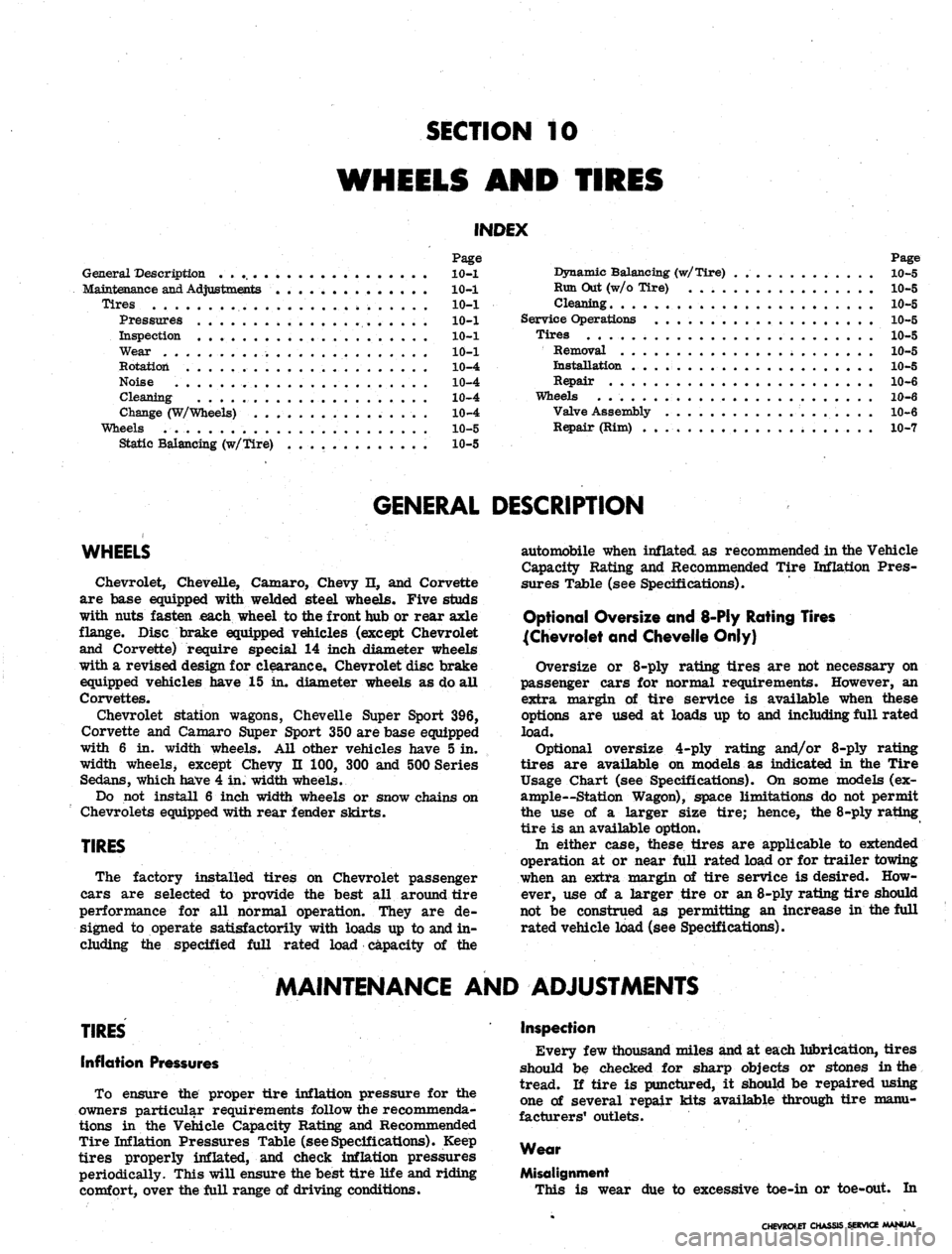
SECTION 10
WHEELS AND TIRES
INDEX
Page
General Description
10-1
Maintenance
and
Adjustments
.............. 10—1
Tires
10-1
Pressures . 10-1
Inspection 10-1
Wear 10-1
Rotation 10-4
Noise 10-4
Cleaning 10-4
Change (W/Wheels) 10-4
Wheels 10-5
Static Balancing (w/Tire) 10-5
Page
Dynamic Balancing (w/Tire) . 10-5
Run Out (w/o Tire) 10-5
Cleaning 10-5
Service Operations 10-5
Tires 10-5
Removal 10-5
Installation 10-5
Repair 10^6
Wheels . 10-6
Valve Assembly 10-6
Repair (Rim) 10-7
GENERAL DESCRIPTION
WHEELS
Chevrolet, Chevelle, Camaro, Chevy n, and Corvette
are base equipped with welded steel wheels. Five studs
with nuts fasten each wheel to the front hub or rear axle
flange. Disc brake equipped vehicles (except Chevrolet
and Corvette) require special 14 inch diameter wheels
with a revised design for clearance, Chevrolet disc brake
equipped vehicles have 15 in. diameter wheels as do all
Corvettes.
Chevrolet station wagons, Chevelle Super Sport 396,
Corvette and Camaro Super Sport 350 are base equipped
with 6 in. width wheels. All other vehicles have 5 in.
width wheels, except Chevy n 100, 300 and 500 Series
Sedans, which have 4 in. width wheels.
Do not install 6 inch width wheels or snow chains on
Chevrolets equipped with rear fender skirts.
TIRES
The factory installed tires on Chevrolet passenger
cars are selected to provide the best all around tire
performance for all normal operation. They are de-
signed to operate satisfactorily with loads up to and in-
cluding the specified full rated load capacity of the
automobile when inflated as recommended in the Vehicle
Capacity Rating and Recommended Tire Inflation Pres-
sures Table (see Specifications).
Optional Oversize and 8-Ply Rating Tires
{Chevrolet and Chevelle Only)
Oversize or 8-ply rating tires are not necessary on
passenger cars for normal requirements. However, an
extra margin of tire service is available when these
options are used at loads up to and including full rated
load.
Optional oversize 4-ply rating and/or 8-ply rating
tires are available on models as indicated in the Tire
Usage Chart (see Specifications). On some models (ex-
ample—Station Wagon), space limitations do not permit
the use of a larger size tire; hence, the 8-ply rating
tire is an available option.
In either case, these tires are applicable to extended
operation at or near full rated load or for trailer towing
when an extra margin of tire service is desired. How-
ever, use of a larger tire or an 8-ply rating tire should
not be construed as permitting an increase in the full
rated vehicle load (see Specifications).
MAINTENANCE AND ADJUSTMENTS
TIRES
Inflation Pressures
To ensure the proper tire inflation pressure for the
owners particular requirements follow the recommenda-
tions in the Vehicle Capacity Rating and Recommended
Tire Inflation Pressures Table (seeSpecifications). Keep
tires properly inflated, and check inflation pressures
periodically. This will ensure the best tire life and riding
comfort, over the full range of driving conditions.
Inspection
Every few thousand miles and at each lubrication, tires
should be checked for sharp objects or stones in the
tread. H tire is punctured, it should be repaired using
one of several repair kits available through tire manu-
facturers1 outlets.
Wear
Misalignment
This is wear due to excessive toe-in or toe-out. In
CHEVROLET CHASSIS SERVICE MANUAL
Page 482 of 659
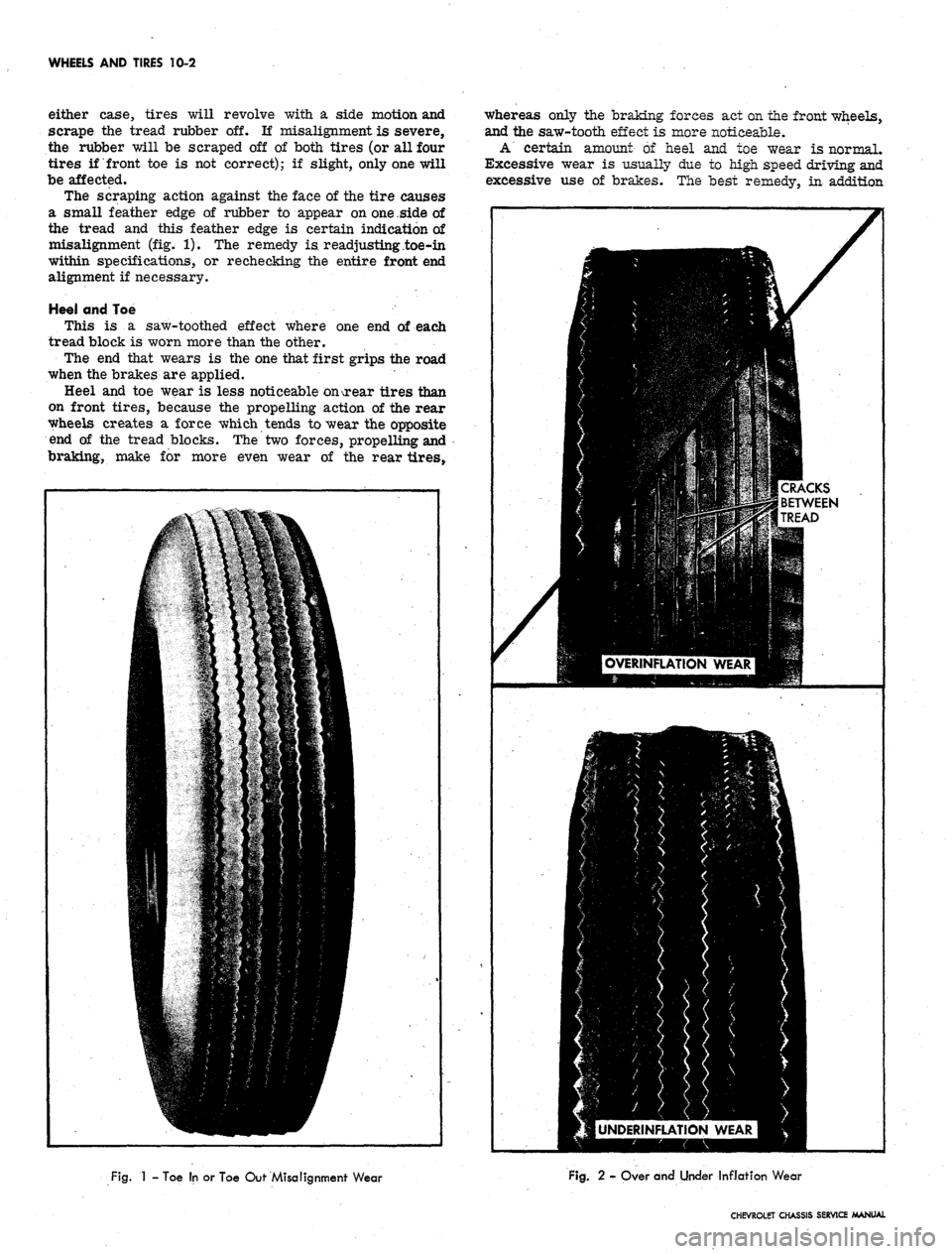
WHEELS AND TIRES 10-2
either case, tires will revolve with a side motion and
scrape the tread rubber off. If misalignment is severe,
the rubber will be scraped off of both tires (or all four
tires if front toe is not correct); if slight, only one will
be affected.
The scraping action against the face of the tire causes
a small feather edge of rubber to appear on
one .side
of
the tread and this feather edge is certain indication of
misalignment (fig. 1). The remedy is. readjusting toe-in
within specifications, or rechecking the entire front end
alignment if necessary.
Heei and Toe
This is a saw-toothed effect where one end of each
tread block is worn more than the other.
The end that wears is the one that first grips the road
when the brakes are applied.
Heel and toe wear is less noticeable onsrear tires than
on front tires, because the propelling action of the rear
wheels creates a force which tends to wear the opposite
end of the tread blocks. The two forces, propelling and
braking, make for more even wear of the rear tires,
whereas only the braking forces act on the front wheels,
and the saw-tooth effect is more noticeable.
A' certain amount of heel and toe wear is normal.
Excessive wear is usually due to high speed driving and
excessive use of brakes. The best remedy, in addition
UNDERINFLATION WEAR
Fig.
1 - Toe In or Toe Out Misalignment Wear
Fig.
2 - Over and Under Inflation Wear
CHEVROLET CHASSIS SERVICE MANUAL
Page 483 of 659
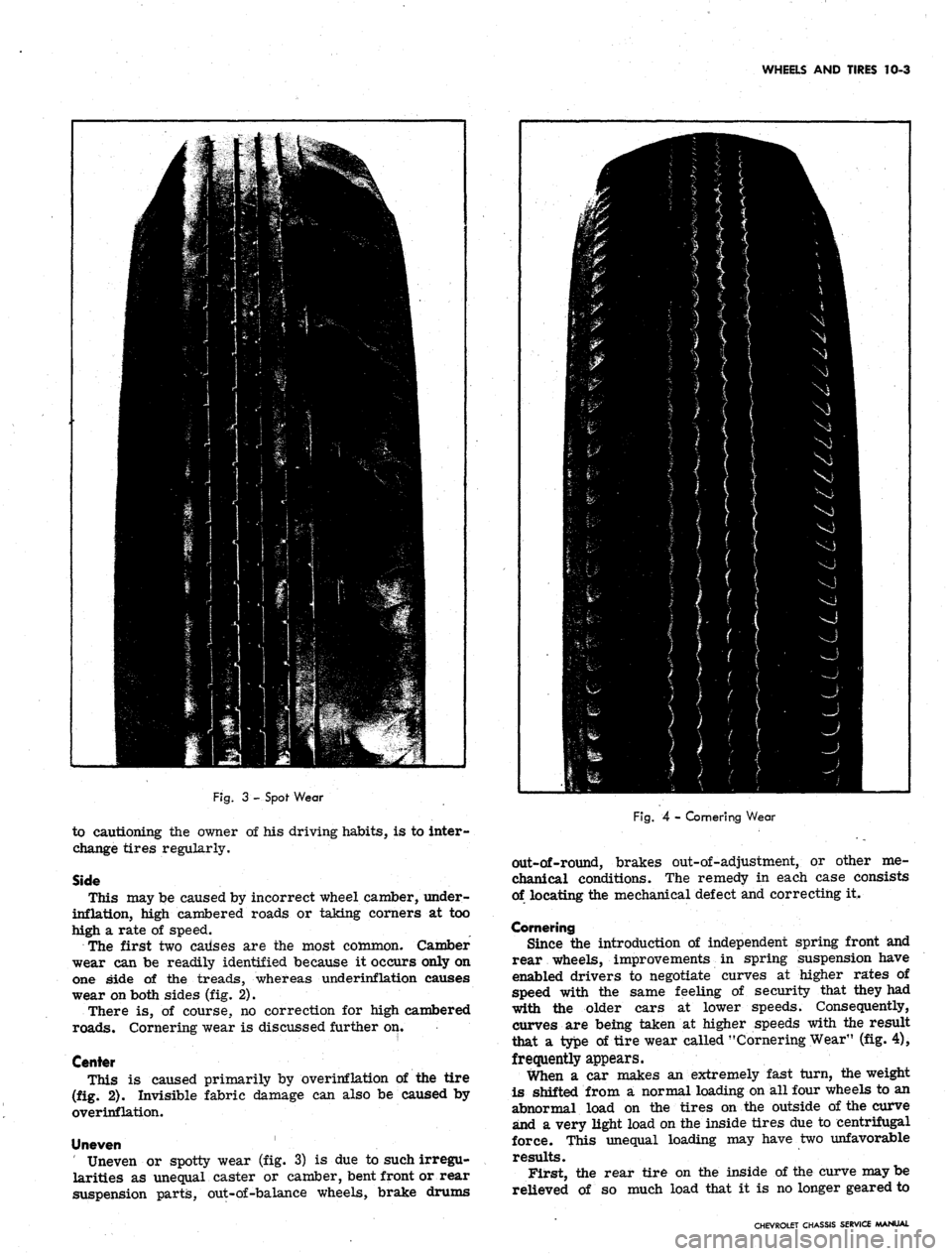
WHEELS AND TIRES 10-3
Fig.
3 - Spof Wear
to cautioning the owner of his driving habits, is to inter-
change tires regularly.
Side
This may be caused by incorrect wheel camber, under-
inflation, high cambered roads or taking corners at too
high a rate of speed.
The first two causes are the most common. Camber
wear can be readily identified because it occurs only on
one side of the treads, whereas underinflation causes
wear on both sides (fig. 2).
There is, of course, no correction for high cambered
roads.
Cornering wear is discussed further on.
Center
This is caused primarily by overinflation pf the tire
(fig. 2). Invisible fabric damage can also be caused by
overinflation.
Uneven
Uneven or spotty wear (fig. 3) is due to such irregu-
larities as unequal caster or camber, bent front or rear
suspension parts, out-of-balance wheels, brake drums
Fig.
4 - Cornering Wear
out-of-round, brakes out-of-adjustment, or other me-
chanical conditions. The remedy in each case consists
of locating the mechanical defect and correcting it.
Cornering
Since the introduction of independent spring front and
rear wheels, improvements in spring suspension have
enabled drivers to negotiate curves at higher rates of
speed with the same feeling of security that they had
with the older cars at lower speeds. Consequently,
curves are being taken at higher speeds with the result
that a type of tire wear called "Cornering Wear" (fig. 4),
frequently appears.
When a car makes an extremely fast turn, the weight
is shifted from a normal loading on all four wheels to an
abnormal load on the tires on the outside of the curve
and a very light load on the inside tires due to centrifugal
force. This unequal loading may have two unfavorable
results.
First, the rear tire on the inside of the curve may be
relieved of so much load that it is no longer geared to
CHEVROLET CHASSIS SERVICE MANUAL
Page 484 of 659
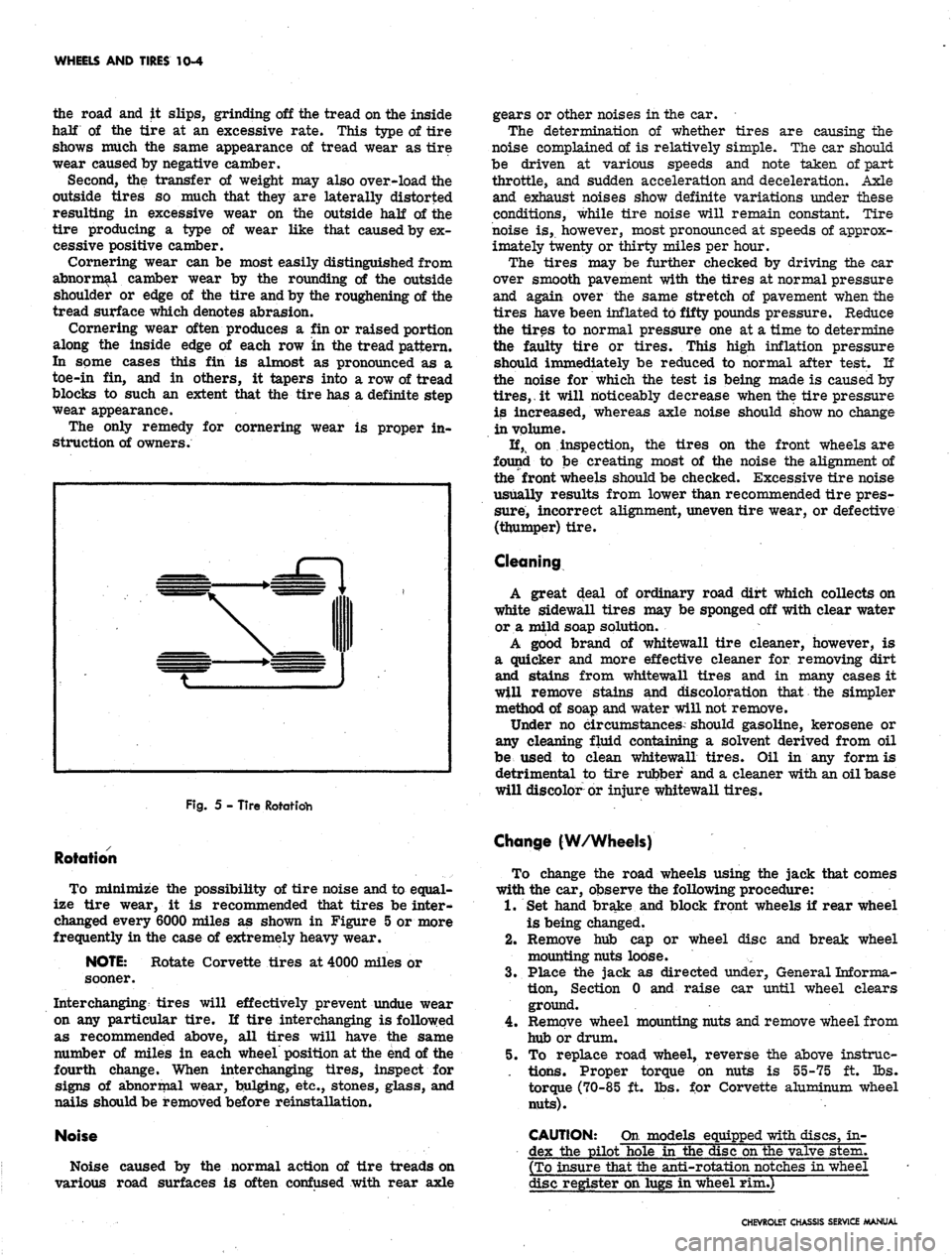
WHEELS AND TIRES 10-4
the road and it slips, grinding off the tread on the inside
half of the tire at an excessive rate. This type of tire
shows much the same appearance of tread wear as tire
wear caused by negative camber.
Second, the transfer of weight may also over-load the
outside tires so much that they are laterally distorted
resulting in excessive wear on the outside half of the
tire producing a type of wear like that caused by ex-
cessive positive camber.
Cornering wear can be most easily distinguished from
abnormal camber wear by the rounding of the outside
shoulder or edge of the tire and by the roughening of the
tread surface which denotes abrasion.
Cornering wear often produces a fin or raised portion
along the inside edge of each row in the tread pattern.
In some cases this fin is almost as pronounced as a
toe-in fin, and in others, it tapers into a row of tread
blocks to such an extent that the tire has a definite step
wear appearance.
The only remedy for cornering wear is proper in-
struction of owners.
Fig.
5 - Tire Rotatidh
Rotation
To minimize the possibility of tire noise and to equal-
ize tire wear, it is recommended that tires be inter-
changed every 6000 miles as shown in Figure 5 or more
frequently in the case of extremely heavy wear.
NOTE:
Rotate Corvette tires at 4000 miles or
sooner.
Interchanging tires will effectively prevent undue wear
on any particular tire. II tire interchanging is followed
as recommended above, all tires will have the same
number of miles in each wheel position at the end of the
fourth change. When interchanging tires, inspect for
signs of abnormal wear, bulging, etc., stones, glass, and
nails should be removed before reinstallation.
Noise
Noise caused by the normal action of tire treads on
various road surfaces is often confused with rear axle
gears or other noises in the car.
The determination of whether tires are causing the
noise complained of is relatively simple. The car should
be driven at various speeds and note taken of part
throttle, and sudden acceleration and deceleration. Axle
and exhaust noises show definite variations under these
conditions, while tire noise will remain constant. Tire
noise is, however, most pronounced at speeds of approx-
imately twenty or thirty miles per hour.
The tires may be further checked by driving the ear
over smooth pavement with the tires at normal pressure
and again over the same stretch of pavement when the
tires have been inflated to fifty pounds pressure. Reduce
the tires to normal pressure one at a time to determine
the faulty tire or tires. This high inflation pressure
should immediately be reduced to normal after test. If
the noise for which the test is being made is caused by
tires,.
it will noticeably decrease when the tire pressure
is increased, whereas axle noise should show no change
in volume.
If, on inspection, the tires on the front wheels are
found to be creating most of the noise the alignment of
the front wheels should be checked. Excessive tire noise
usually results from lower than recommended tire pres-
sure, incorrect alignment, uneven tire wear, or defective
(thumper) tire.
Cleaning
A great deal of ordinary road dirt which collects on
white sidewall tires may be sponged off with clear water
or a mild soap solution.
A good brand of whitewall tire cleaner, however, is
a quicker and more effective cleaner for removing dirt
and stains from whitewall tires and in many cases it
will remove stains and discoloration that the simpler
method of soap and water will not remove.
Under no circumstances should gasoline, kerosene or
any cleaning fluid containing a solvent derived from oil
be used to clean whitewall tires. Oil in any form is
detrimental to tire rubber and a cleaner with an oil base
will discolor or injure whitewall tires.
Change (W/Wheels)
To change the road wheels using the jack that comes
with the car, observe the following procedure:
1.
Set hand brake and block front wheels if rear wheel
is being changed.
2.
Remove hub cap or wheel disc and break wheel
mounting nuts loose.
3.
Place the jack as directed tinder, General Informa-
tion,
Section 0 and raise car until wheel clears
ground.
4.
Remove wheel mounting nuts and remove wheel from
hub or drum.
5. To replace road wheel, reverse the above instrue-
. tions. Proper torque on nuts is 55-75 ft. lbs.
torque (70-85 ft. lbs. for Corvette aluminum wheel
nuts).
CAUTION: On models equipped with discs, in-
dex the pilot hole in the disc on the valve stem.
(To insure that the anti-rotation notches in wheel
disc register on lugs in wheel rim.)
CHEVROLET CHASSIS SERVICE MANUAL
Page 485 of 659
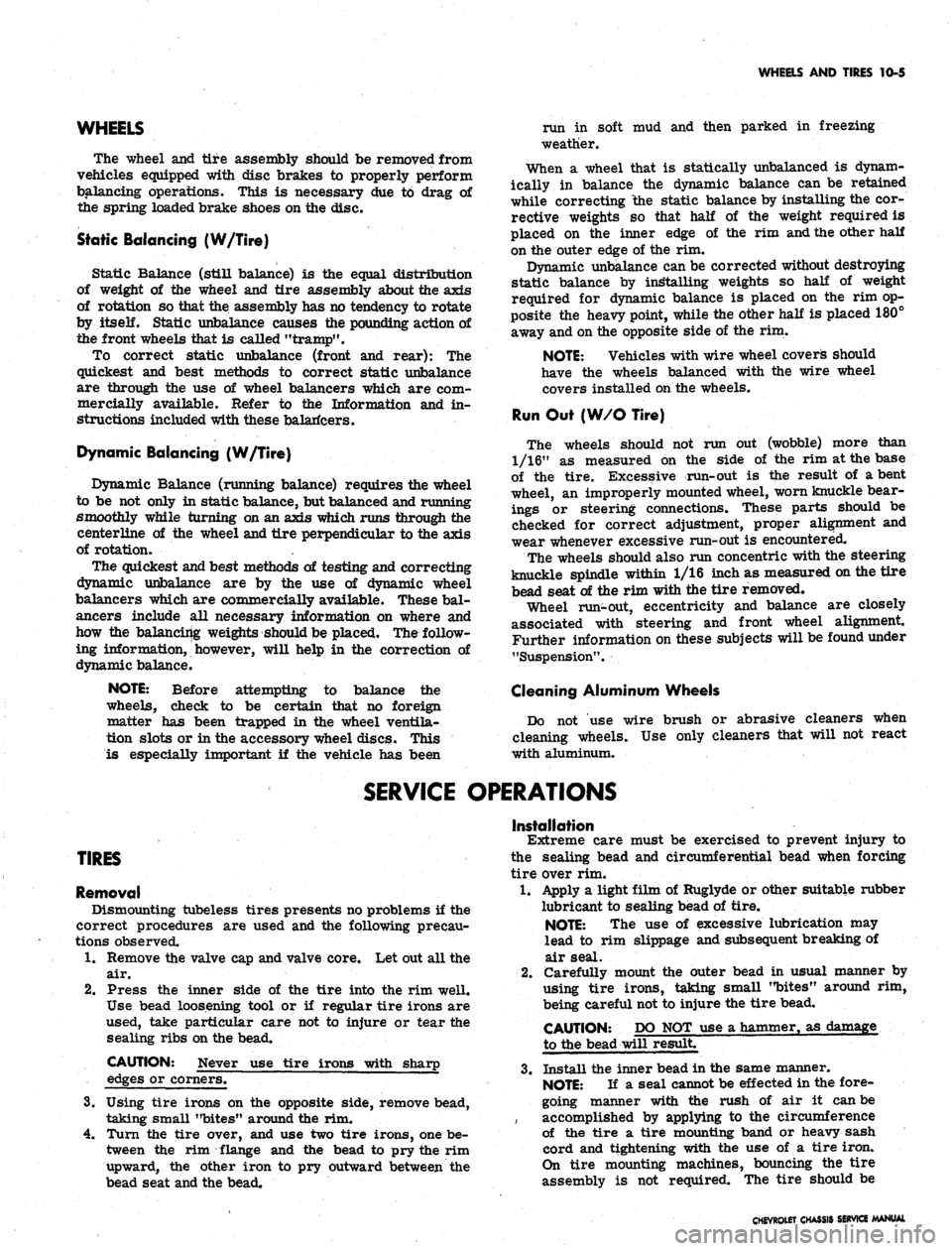
WHEELS AND TIRES 10-5
WHEELS
The wheel and tire assembly should be removed from
vehicles equipped with disc brakes to properly perform
balancing operations. This is necessary due to drag of
the spring loaded brake shoes on the disc.
Static Balancing (W/Tire)
Static Balance (still balance) is the equal distribution
of weight of the wheel and tire assembly about the axis
of rotation so that the assembly has no tendency to rotate
by
itself.
Static unbalance causes the pounding action of
the front wheels that is called "tramp".
To correct static unbalance (front and rear): The
quickest and best methods to correct static unbalance
are through the use of wheel balancers which are com-
mercially available. Refer to the Information and in-
structions included with these balaricers.
Dynamic Balancing (W/Tire)
Dynamic Balance (running balance) requires the wheel
to be not only in static balance, but balanced and running
smoothly while turning on an axis which runs through the
centerline of the wheel and tire perpendicular to the axis
of rotation.
The quickest and best methods of testing and correcting
dynamic unbalance are by the use of dynamic wheel
balancers which are commercially available. These bal-
ancers include all necessary information on where and
how the balancing weights should be placed. The follow-
ing information, however, will help in the correction of
dynamic balance.
NOTE:
Before attempting to balance the
wheels, check to be certain that no foreign
matter has been trapped in the wheel ventila-
tion slots or in the accessory wheel discs. This
is especially important if the vehicle has been
run in soft mud and then parked in freezing
weather.
When a wheel that is statically unbalanced is dynam-
ically in balance the dynamic balance can be retained
while correcting "the static balance by installing the cor-
rective weights so that half of the weight required is
placed on the inner edge of the rim and the other half
on the outer edge of the rim.
Dynamic unbalance can be corrected without destroying
static balance by installing weights so half of weight
required for dynamic balance is placed on the rim op-
posite the heavy point, while the other half is placed 180°
away and on the opposite side of the rim.
NOTE:
Vehicles with wire wheel covers should
have the wheels balanced with the wire wheel
covers installed on the wheels.
Run Out (W/OTire)
The wheels should not run out (wobble) more than
1/16" as measured on the side of the rim at the base
of the tire. Excessive run-out is the result of a bent
wheel, an improperly mounted wheel, worn knuckle bear-
ings or steering connections. These parts should be
checked for correct adjustment, proper alignment and
wear whenever excessive run-out is encountered.
The wheels should also run concentric with the steering
knuckle spindle within 1/16 inch as measured on the tire
bead seat of the rim with the tire removed.
Wheel run-out, eccentricity and balance are closely
associated with steering and front wheel alignment.
Further information on these subjects will be found under
"Suspension".
Cleaning Aluminum Wheels
Do not use wire brush or abrasive cleaners when
cleaning wheels. Use only cleaners that will not react
with aluminum.
SERVICE OPERATIONS
TIRES
Removal
Dismounting tubeless tires presents no problems if the
correct procedures are used and the following precau-
tions observed.
1.
Remove the valve cap and valve core. Let out all the
air.
2.
Press the inner side of the tire into the rim well.
Use bead loosening tool or if regular tire irons are
used, take particular care not to injure or tear the
sealing ribs on the bead.
CAUTION: Never use tire irons with sharp
edges or corners.
3.
Using tire irons on the opposite side, remove bead,
taking small "bites" around the rim.
4.
Turn the tire over, and use two tire irons, one be-
tween the rim flange and the bead to pry the rim
upward, the other iron to pry outward between the
bead seat and the bead.
Installation
Extreme care must be exercised to prevent injury to
the sealing bead and circumferential bead when forcing
tire over rim.
1.
Apply a light film of Ruglyde or other suitable rubber
lubricant to sealing bead of tire.
NOTE:
The use of excessive lubrication may
lead to rim slippage and subsequent breaking of
air seal.
2.
Carefully mount the outer bead in usual manner by
using tire irons, taking small "bites" around rim,
being careful not to injure the tire bead.
CAUTION: DO NOT use a hammer, as damage
to the bead will result.
3.
Install the inner bead in the same manner.
NOTE:
If a seal cannot be effected in the fore-
going manner with the rush of air it can be
, accomplished by applying to the circumference
of the tire a tire mounting band or heavy sash
cord and tightening with the use of a tire iron.
On tire mounting machines, bouncing the tire
assembly is not required. The tire should be
CHEVROLET CHASSIS SERVICE MANUAL
Page 486 of 659
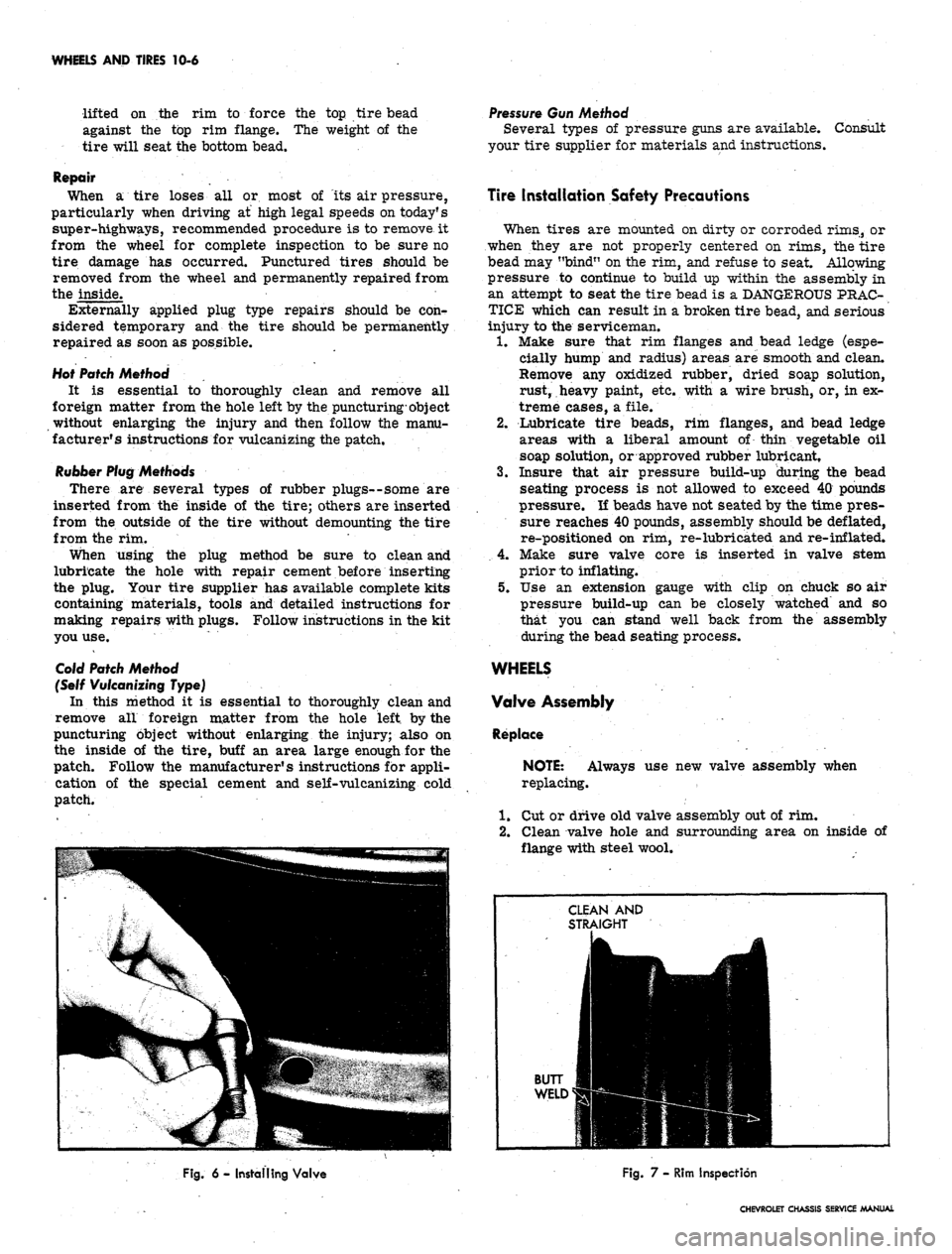
WHEELS AND TIRES
10-6
lifted on the rim to force the top tire bead
against the top rim flange. The weight of the
tire will seat the bottom bead.
Repair
When a tire loses all or most of its air pressure,
particularly when driving at high legal speeds on today1 s
super-highways, recommended procedure is to remove it
from the wheel for complete inspection to be sure no
tire damage has occurred. Punctured tires should be
removed from the wheel and permanently repaired from
the inside.
Externally applied plug type repairs should be con-?
sidered temporary and the tire should be permanently
repaired as soon as possible.
Hot Patch Method
It is essential to thoroughly clean and remove all
foreign matter from the hole left by the puncturing-object
without enlarging the injury and then follow the manu-
facturer's instructions for vulcanizing the patch.
Rubber Plug Methods
There are several types of rubber plugs--some are
inserted from the inside of the tire; others are inserted
from the outside of the tire without demounting the tire
from the rim.
When using the plug method be sure to clean and
lubricate the hole with repair cement before inserting
the plug. Your tire supplier has available complete kits
containing materials, tools and detailed instructions for
making repairs with plugs. Follow instructions in the kit
you use.
Cold Patch Method
(Self Vulcanizing Type)
In this method it is essential to thoroughly clean and
remove all foreign matter from the hole left by the
puncturing object without enlarging the injury; also on
the inside of the tire, buff an area large enough for the
patch. Follow the manufacturer1 s instructions for appli-
cation of the special cement and self-vulcanizing cold
patch.
Pressure Gun Method
Several types of pressure guns are available. Consult
your tire supplier for materials and instructions.
Tire Installation Safety Precautions
When tires are mounted on dirty or corroded rims, or
when they are not properly centered on rims, the tire
bead may "bind" on the rim, and refuse to seat. Allowing
pressure to continue to build up within the assembly in
an attempt to seat the tire bead is a DANGEROUS PRAC-
TICE which can result in a broken tire bead, and serious
injury to the serviceman.
1.
Make sure that rim flanges and bead ledge (espe-
cially hump and radius) areas are smooth and clean.
Remove any oxidized rubber, dried soap solution,
rust, heavy paint, etc. with a wire brush, or, in ex-
treme cases, a file.
2.
Lubricate tire beads, rim flanges, and bead ledge
areas with a liberal amount of thin vegetable oil
soap solution, or approved rubber lubricant,
3.
Insure that air pressure build-up during the bead
seating process is not allowed to exceed 40 pounds
pressure. If beads have not seated by the time pres-
sure reaches 40 pounds, assembly should be deflated,
re-positioned on rim, re-lubricated and re-inflated.
4.
Make sure valve core is inserted in valve stem
prior to inflating.
5.
Use an extension gauge with clip on chuck so air
pressure build-up can be closely watched and so
that you can stand well back from the assembly
during the bead seating process.
WHEELS
Valve Assembly
Replace
NOTE: Always use new valve assembly when
replacing.
1.
Cut or drive old valve assembly out of rim.
2.
Clean valve hole and surrounding area on inside of
flange with steel wool.
Fig. 6 - Installing Valve
Fig. 7 - Rim Inspection
CHEVROLET CHASSIS SERVICE MANUAL
Page 487 of 659
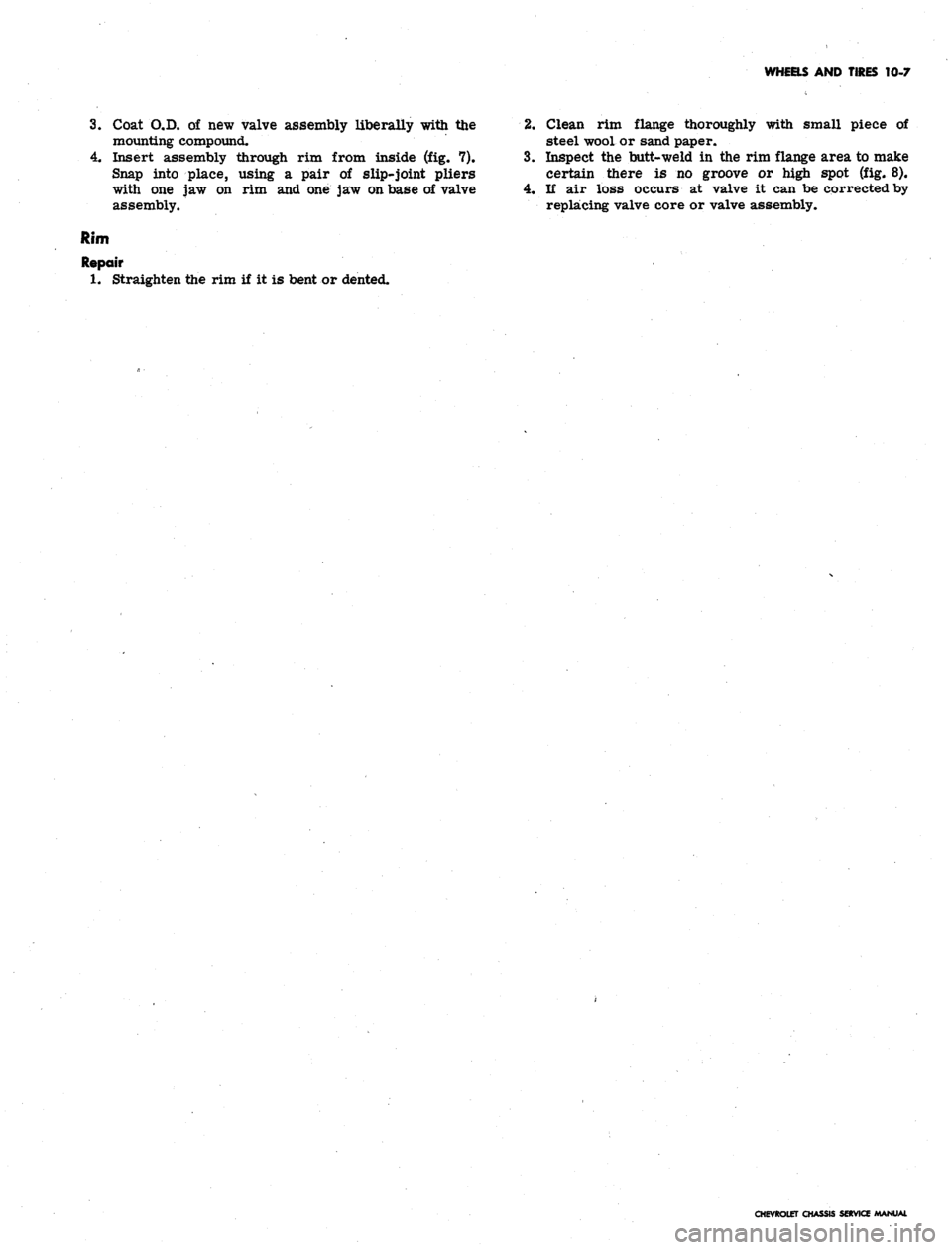
WHEELS AND TIRES 10-7
3.
Coat O.D. of new valve assembly liberally with the 2. Clean rim flange thoroughly with small piece of
mounting compound. steel wool or sand paper.
4.
Insert assembly through rim from inside (fig. 7). 3. Inspect the butt-weld in the rim flange area to make
Snap into place, using a pair of slip-joint pliers certain there is no groove or high spot (fig. 8).
with one jaw on rim and one jaw on base of valve 4. If air loss occurs at valve it can be corrected by
assembly. replacing valve core or valve assembly.
Rim
Repair
1.
Straighten the rim if it is bent or dented.
CHEVROLET CHASSIS SERVICE MANUAL
Page 488 of 659
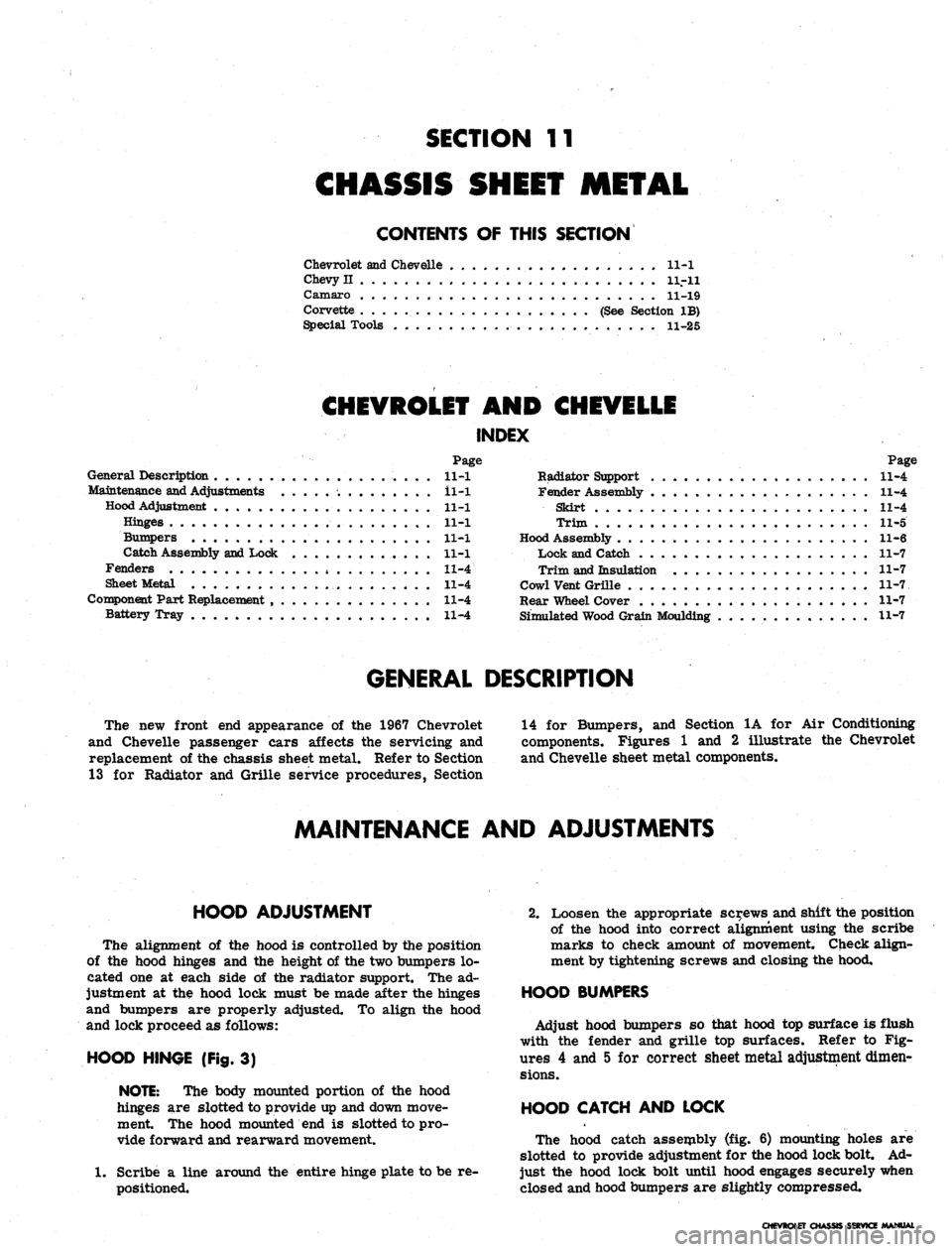
SECTION 11
CHASSIS SHEET METAL
CONTENTS OF THIS SECTION
Chevrolet and Chevelle 11-1
Chevy II . . 11.-11
Camaro 11-19
Corvette (See Section IB)
Special Tools 11-25
CHEVROLET AND CHEVELLE
INDEX
Page
General Description 11-1
Maintenance and Adjustments •. il-1
Hood Adjustment 11-1
Hinges 11-1
Bumpers 11-1
Catch Assembly and Lock 11-1
Fenders 11-4
Sheet Metal 11-4
Component Part Replacement 11-4
Battery Tray 11-4
Page
Radiator Support 11-4
Fender Assembly . . 11-4
Skirt 11-4
Trim 11-5
Hood Assembly 11-6
Lock and Catch 11-7
Trim and Insulation 11-7
Cowl Vent Grille 11-7
Rear Wheel Cover 11-7
Simulated Wood Grain Moulding . . . . 11-7
GENERAL DESCRIPTION
The new front end appearance of the 1967 Chevrolet
and Chevelle passenger cars affects the servicing and
replacement of the chassis sheet metal. Refer to Section
13 for Radiator and Grille service procedures, Section
14 for Bumpers, and Section 1A for Air Conditioning
components. Figures 1 and 2 illustrate the Chevrolet
and Chevelle sheet metal components.
MAINTENANCE AND ADJUSTMENTS
HOOD ADJUSTMENT
The alignment of the hood is controlled by the position
of the hood hinges and the height of the two bumpers lo-
cated one at each side of the radiator support. The ad-
justment at the hood lock must be made after the hinges
and bumpers are properly adjusted. To align the hood
and lock proceed as follows:
HOOD HINGE (Fig. 3)
NOTE:
The body mounted portion of the hood
hinges are slotted to provide up and down move-
ment. The hood mounted end is slotted to pro-
vide forward and rearward movement.
1.
Scribe a line around the entire hinge plate to be re-
positioned.
2.
Loosen the appropriate screws and shift the position
of the hood into correct alignment using the scribe
marks to check amount of movement. Check align-
ment by tightening screws and closing the hood.
HOOD BUMPERS
Adjust hood bumpers so that hood top surface is flush
with the fender and grille top surfaces. Refer to Fig-
ures 4 and 5 for correct sheet metal adjustment dimen-
sions.
HOOD CATCH AND LOCK
The hood catch assembly (fig. 6) mounting holes are
slotted to provide adjustment for the hood lock bolt. Ad-
just the hood lock bolt until hood engages securely when
closed and hood bumpers are slightly compressed.
CHEVROLET CHASSIS SERVICE MANUAL
Page 489 of 659
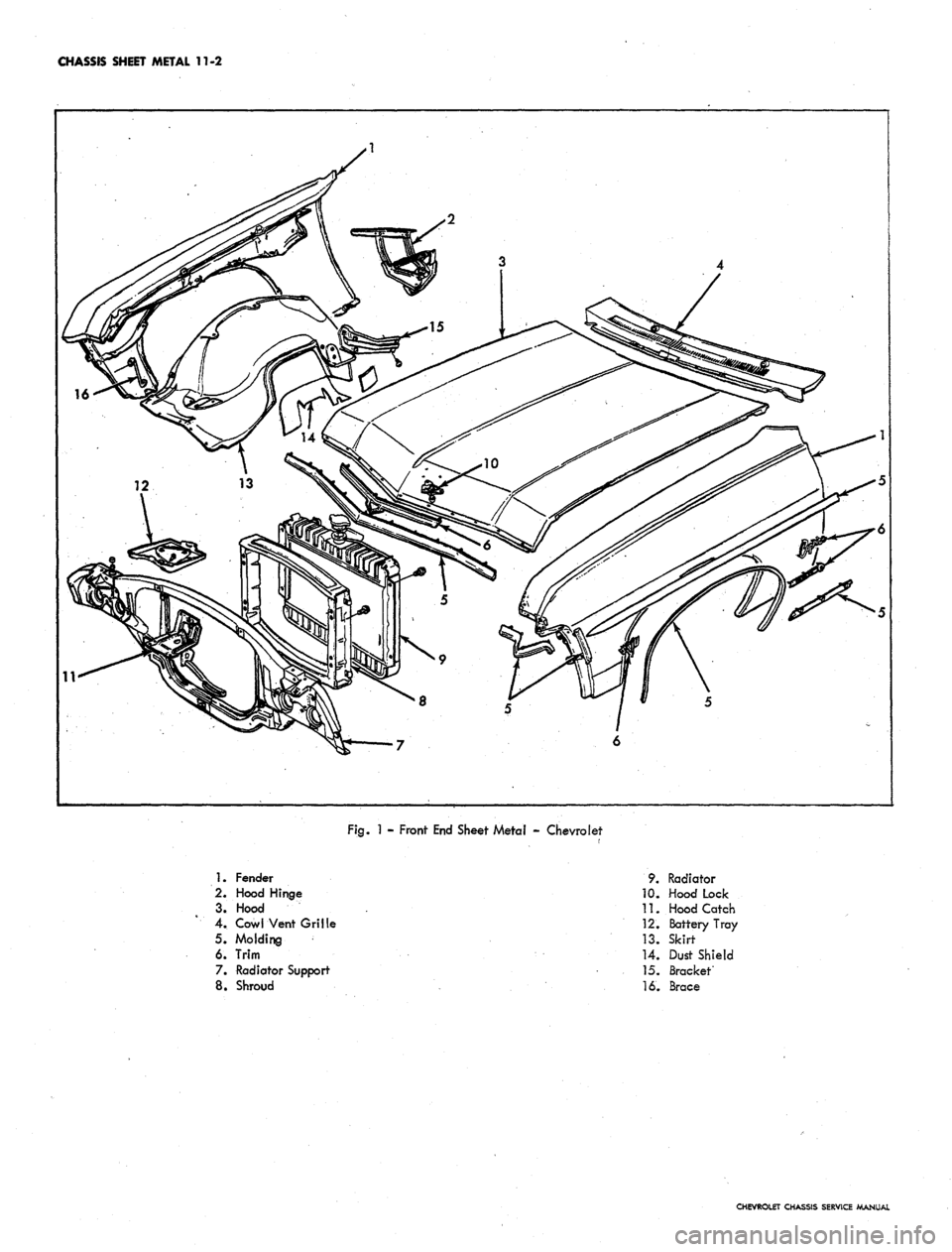
CHASSIS SHEET METAL 11-2
Fig.
1
- Front End Sheet Metal - Chevrolet
1.
Fender
2.
Hood Hinge
3. Hood
4.
Cowl Vent Grille
5. Molding
6. Trim
7. Radiator Support
8. Shroud
9. Radiator
10.
Hood Lock
11.
Hood Catch
12.
Battery Tray
13.
Skirt
14.
Dust Shield
15.
Bracket'
16.
Brace
CHEVROLET CHASSIS SERVICE MANUAL
Page 490 of 659
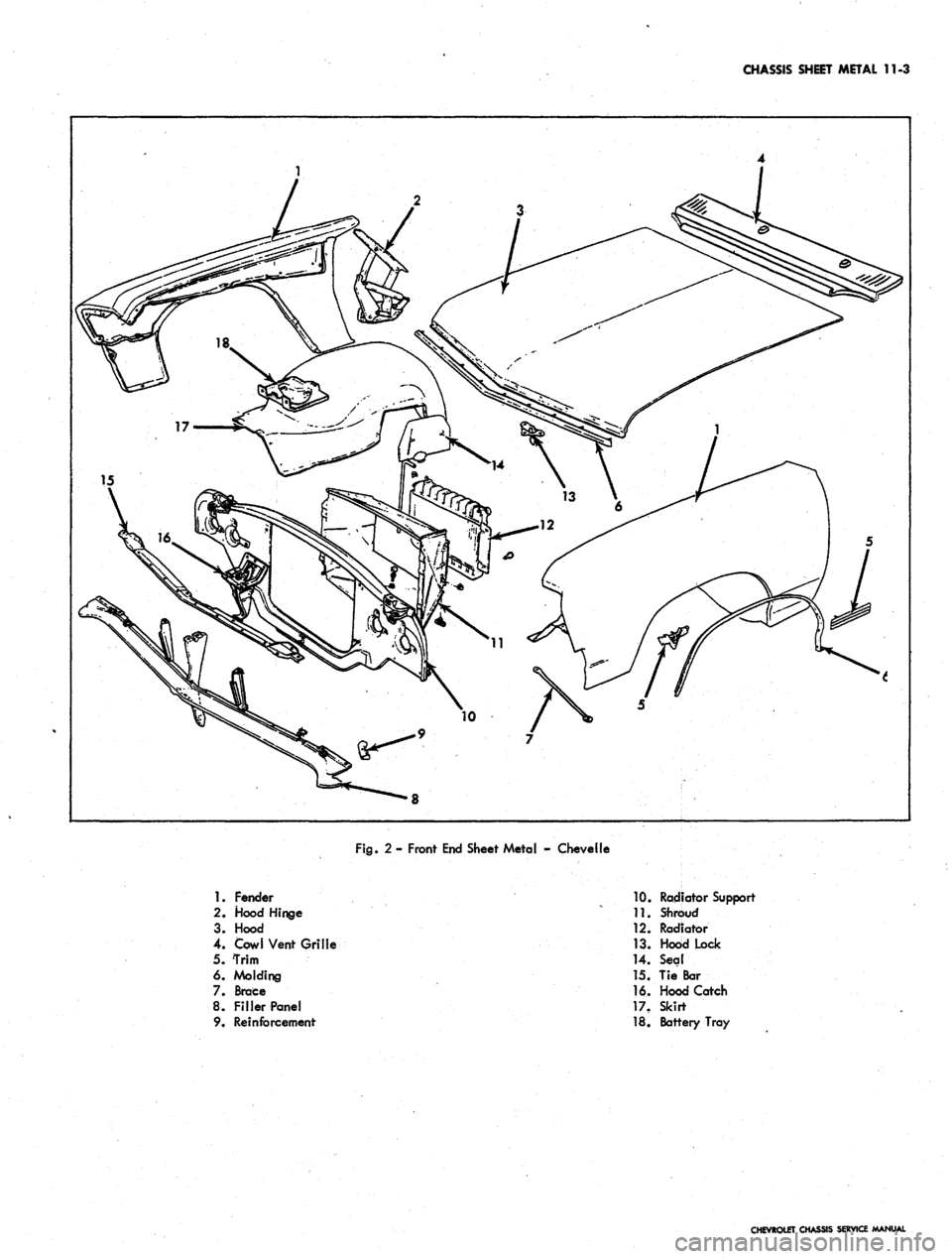
CHASSIS SHEET METAL 11-3
Fig.
2 - Front End Sheet Metal - Chevelle
1.
Fender
2.
Hood Hinge
3. Hood
4.
Cowl Vent Grille
5. Trim
6. Molding
7. Brace
8. Filler Panel
9. Reinforcement
10.
Radiator Support
11.
Shroud
12.
Radiator
13.
Hood Lock
14.
Seal
15.
Tie Bar
16.
Hood Catch
17.
Skirt
18.
Battery Tray
CHEVROLET CHASSIS SERVICE MANUAL